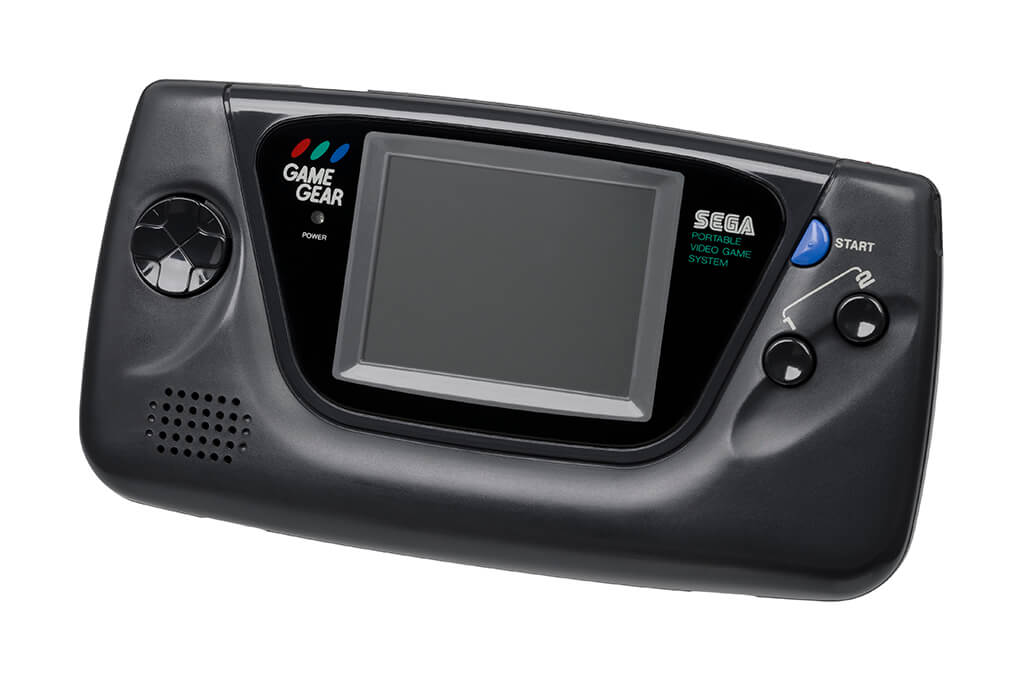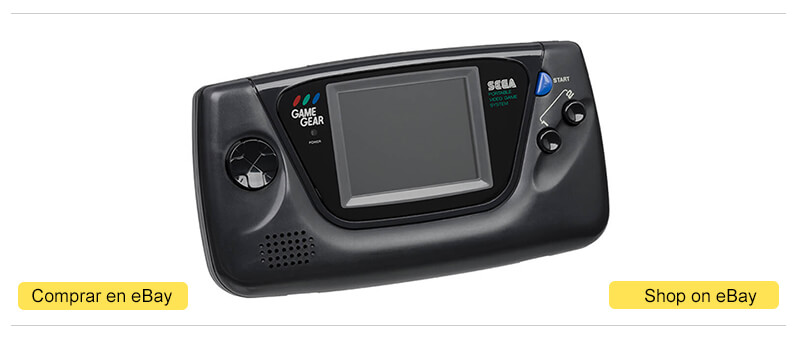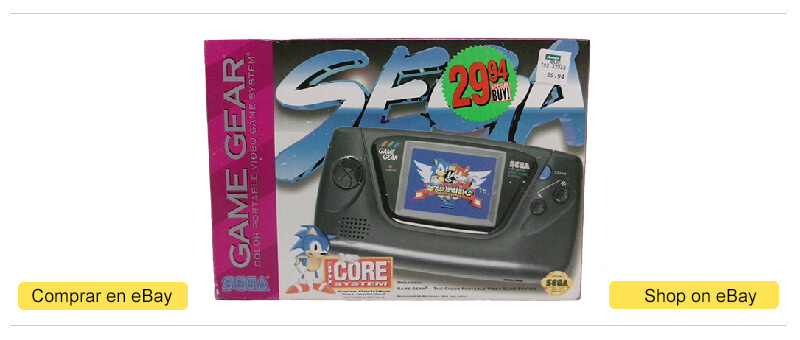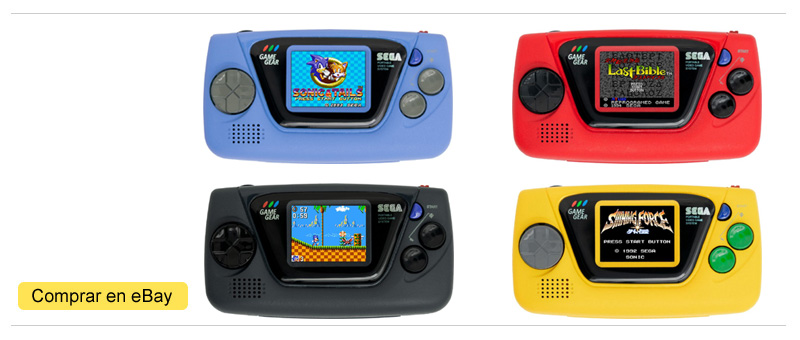Game Gear was released on October 6, 1990 in Japan as SEGA’s response to Nintendo’s well-known handheld, the Game Boy. With features superior to the Master System and a catalog of similar quality, the Game Gear was a worthy adversary and a magnificent console.
Much more powerful than its rival and with a full-color backlit screen, its 6 batteries and short duration of playing time, sentenced it to an eternal second position in the Battle of the 8-bit portable consoles.
| COMPANY: | SEGA |
| CONSOLE GENERATION: | 3RD GENERATION OF CONSOLES |
| RELEASE DATE: | October 6, 1990 in Japan April 1991 in North America and Europe |
| GAMES CATALOGUE: | 364 games |
| SOLD UNITS: | 14 million worldwide |
| LAUNCH PRICE: | 19,800 yen in Japan $149.99 in the United States |
| PROCESSOR: | Z80A (3,58 MHz) |
| FORMAT: | Cartridge |
| BUY IT ON EBAY: | https://ebay.us/CnegjU |
- History of the Game Gear.
- Portable comparison: Game Gear VS Game Boy VS Atari Lynx.
- Models and evolution of the Game Gear.
- Price of a SEGA Game Gear console. How much?
- Collecting the Game Gear portable console.
- Buying a second hand Game Gear.
- TOP Retro: Best Game Gear games.
- FAQ Game Gear.
- Technical characteristics of the Sega Game Gear.
Game Gear, SEGA’s portable console
Game Gear was SEGA’s first portable console, a machine created to conquer a new market niche in the video game industry, that of portable consoles. Nintendo had revolutionized video games with its Game Boy, validating a business model SEGA wanted its share of.
Coming from the business of arcade games and arcade machines, SEGA entered the domestic market in the early 80’s with the SG-1000 (1983), a system that evolved into the Master System (1986) and the compact Master System II (1989). ). Consequently, since the late 80’s SEGA already had a base for its portable console.
Created by Hiroshi Yagi, the Game Gear was SEGA’s hasty response to face the Atari Lynx and Nintendo Game Boy, so from the beginning its design, development and production was aimed at surpassing its rivals, Sega having full knowledge of the technical characteristics and benefits of its competition.
Hiroshi Yagi | Engineer and developer | SEGA Born in 1950 in Tokyo and graduated from Nihon University (a private university located in Tokyo), Hiroshi Yagi began working at SEGA in 1975 with pinball machines, later making the leap to the development of arcade machine hardware in the midst of the transition from analog electromechanical arcade machines to the digital technology of the microchip. Hiroshi was one of those responsible for the design of legendary arcade boards such as the System 2, the OutRun hardware and its X and Y boards, and in 1989 he designed the Game Gear hardware. Years later he continued working with the Model 1 (1992), Model 2 (1993) and Model 3 (1996) boards, limiting himself in the following years to supervising the new arcade hardware, which was conditioned by home consoles, so did not require much of his knowledge as an engineer: NAOMI and NAOMI 2 (Dreamcast), Triforce (Game Cube) and Chihiro (Xbox). As we can see, the Game Gear was designed by a great in the video game industry, a fact that is reflected in the enormous features of the SEGA laptop in relation to its time.
Project Mercury was the code name chosen for the development of the Game Gear, a console created to defeat a technical beast such as the Atari Lynx and the people’s console, the Game Boy, a machine perfectly balanced in price, performance and consumption. Of battery.
Game Gear chose to place itself in an intermediate place between the more than advanced Lynx for its time and the humble Game Boy, and it really succeeded: With a horizontal format and a size and weight intermediate between its two competitors, the Game Gear had a magnificent backlit color LCD screen and performance comparable or even superior to the Master System/Sega Mark III, with which it shared the same compact hardware configuration.
In short, the result was a great portable console, which offered us practically the entire catalog of SEGA home consoles, in the palm of our hand and ready to play anywhere, anytime… Something that its main competitor he could not do until many years later.
Offering almost the entire catalog of SEGA’s 8-bit home consoles, as well as exclusive games and MegaDrive conversions, when we are talking about 1990 (the year in which the ZX Spectrum was still triumphing in Europe), at the time it was a real madness.
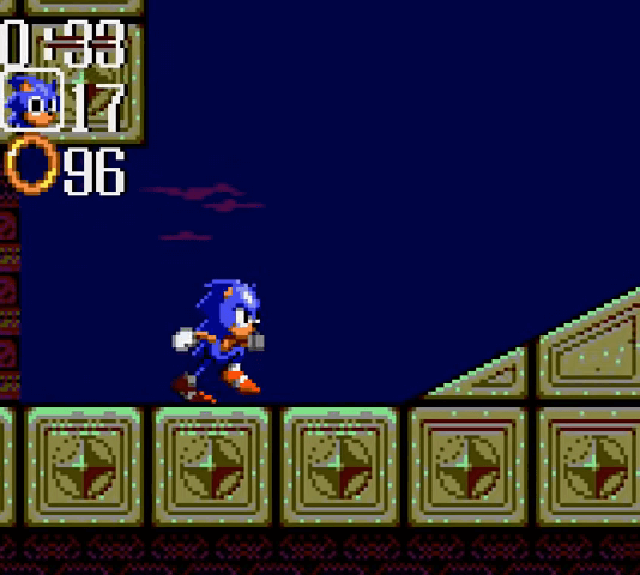
It is true that the price of the Game Gear was higher than that of the Game Boy, but its features were clearly superior and its catalog of games, even far from the enormous offer existing on the Nintendo console, offered us an entry to the entire universe. SEGA, wonderful.
As we all know decades later, Game Gear could do little or nothing in the face of the global success of the Game Boy, in the same way that the Famicom destroyed the Sega Mark III and its previous consoles, SEGA made two enormous mistakes in the design of its portable console:
- Battery consumption: With the price of batteries sky-high in the 90s, 6 AA alkaline batteries lasting 3 hours was not acceptable for a normal family, so SEGA’s portable console became a portable console, which required the power adapter at all times to be able to enjoy it.
What if a game lasted more than 3 hours? What if we wanted to gain experience in an RPG? What if the batteries weren’t new and we only had 40 minutes of gameplay left? The solution was passwords… or the Game Boy and its almost 30 hours of gameplay. - The size: As adults, we may consider the size of the Game Gear acceptable to go from the shelf to our hands, but in the 90’s consoles were still considered child’s play, and therefore their target audience was the childish. The Game Gear was too big to fit in the pockets of a public who wanted to take it to the schoolyard, restaurants and friends’ houses, so in practice it was not portable.
A real shame, as we were able to see years later with the arrival of the Game Boy Color, it was not until 1998 that color LCD screen technology was mature enough to be integrated into a gaming device, with acceptable battery consumption. (10 hours of play). Once again, SEGA was ahead of its time.
In their eagerness to outdo Nintendo, Sega made the same mistake as Atari and failed to launch a balanced enough console for a general audience. Even so, Game Gear had a relative commercial success, remaining active by SEGA until 1997, achieving sales of more than 14 million consoles worldwide. Nothing bad…
The marketing strategy of the Game Gear: Color and the TV Tuner.

Being very aware of its strengths, SEGA created a marketing campaign focused on the color that its console offered, making direct or veiled references to its most direct competitor, the Nintendo Game Boy.
Through advertisements on television and mainly in specialized magazines, everyone witnessed the benefits of the Game Gear, which focused on an audience not as childish as Nintendo’s, very much in line with the strategy followed by SEGA in the 80’s and 90’s.
To its technical features, SEGA very skillfully added one of the theoretically best peripherals that have ever been created, its TV Tuner: In a few years in which there was only one television in the home in continuous family dispute, SEGA sold its console as a potential portable television… Master move.
The only problem with such a brilliant idea was the price of the TV Tuner, which in 1993 was still around 14,000 Pts (Spain). A ridiculously excessive price for a children’s audience. The result was that the TV tuner was a good marketing tool, a possibility or hope that very few players could enjoy.
To confront the Tetris phenomenon and its brutal combo with the Game Boy as a starting pack, SEGA launched its console in the West with Columns, a Tetris-style game but based, as it could not be otherwise, on color.
The current gaming experience and nostalgia
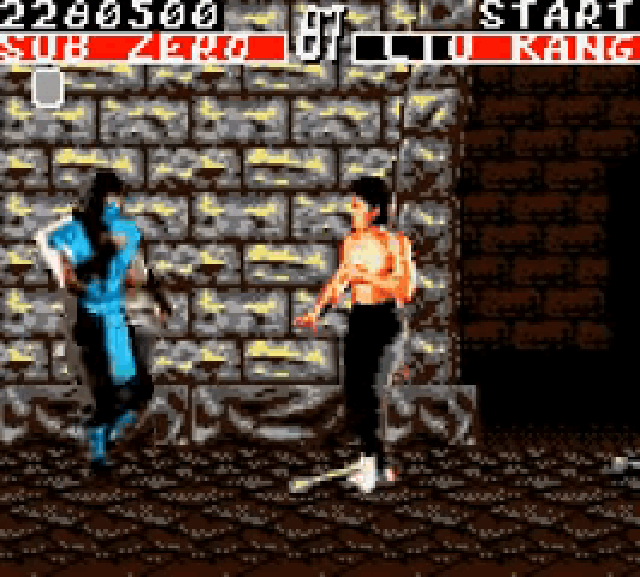
If you are already old, for most players at that time the Game Gear is the console that you wanted to have and didn’t have, since you had the Game Boy. It is the console that you looked at with envy in the schoolyard, while you defended like a fanboy the benefits of your Game Boy in debates about consoles and brands, Game Gear is the laptop with which they played Sonic in full color under the sheets, while You were looking for a flashlight all over your house…
Surely, your nostalgia for the Game Gear is not direct, personal, you did not enjoy it as an owner, you played it at some point, yes, but it is not the same nostalgia, it is the nostalgia of what you wanted and did not have… And that! It’s very good for retro video game lovers!
Playing the Game Gear game catalog today is enjoying what a lucky few were able to do in the past, it is being amazed by what a machine from the early 90s could offer us, becoming technically above its sisters. greater than 8 bits.
The Game Gear gaming experience today is good, very good. A perfect ergonomic machine for our adult hands, it opens the door to the entire SEGA universe in its best years, the 8 and 16 bits (ports). It is what you expect, what you know even if you were born after 2000, platform games, direct action and with notable and varied exceptions as we will see in the TOP section: Best Game Gear games.
So I hope I have made it clear, for those of you who enjoyed the Game Gear or Master System at the time, the SEGA laptop is 100% good nostalgia, for those who were not that lucky due to age or having the Nintendo laptop , the Game Gear gaming experience is still great and suitable for all audiences.
But be careful! We are looking at a portable machine from 1990, so we cannot expect image and sound quality comparable to current consoles. On the other hand, the passage of time has generated problems in the capacitors and the console screen, so these machines need to undergo maintenance to avoid greater problems...
My personal experience
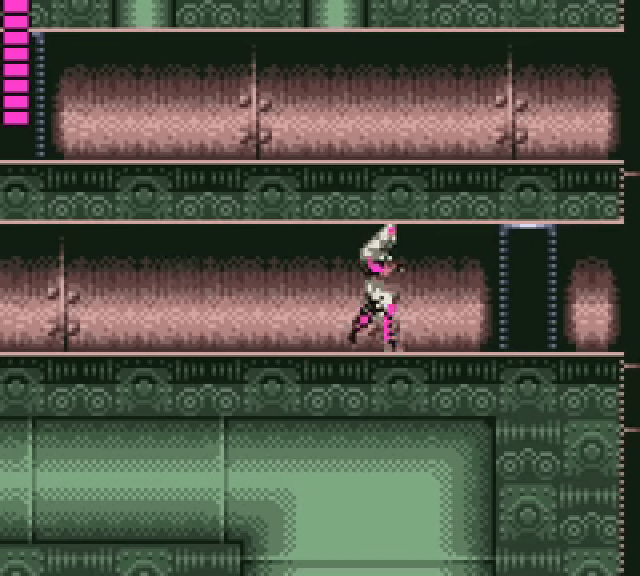
Rarely in Infoconsolas console analyzes do I include a section as personal as this one, but on this occasion I consider that it contributes enough to share it with all of you:
At about 11 years old and with a 4-year-old little brother and a Game Boy bought with a lot of effort, in my house we were lucky enough to win a giveaway for a Game Boy from a well-known brand of chips, so in our home we suddenly had to have 2 Game Boy.
In the early 90’s, having 2 portable Nintendo consoles was not synonymous with multiplayer, since 2 cartridges of the same game were necessary to play doubles (something impossible in a single home), so when a classmate told me proposed the following deal/exchange soon to accept:
He gave me his used Game Gear, without the box and with a power adapter, plus about 5 or 6 games and I gave him an almost new Game Boy with Tetris. In this way, the Game Gear came into my life with Columns, Sonic, Shinobi and Dragon Crystal among others, providing me with a new universe to discover, the SEGA UNIVERSE.
From this simple fact, this exchange between kids in the middle of puberty, I want to highlight a couple of significant points that help to understand what the situation was like in those years in the world of video games, specifically in the case of the Game Gear and laptops:
- My friend succumbed to the “Nintendo pressure”, we all had the Game Boy.
- My friend finally had access to an immense catalog of video games, the Game Boy.
- My friend had gotten tired of playing on the wall next to an outlet.
- I was amazed by the console’s graphics.
- My father was amazed at how much he spent on batteries for the console.
- I started playing on a wall next to a socket.
- Suddenly, I had access to a select and small group of wealthy but marginalized Game Gear owners to exchange games.
- Once I realized the lack of use I could make of the console as a portable device, I never bought a new Game Gear game (yes, a Game Boy).
- The one who had the Lynx in my class stayed as he was.
Portable comparison: Game Gear VS Game Boy VS Atari Lynx
| GAME GEAR | GAME BOY | ATARI LYNX | |
| Launch | 1990 | 1989 | 1989 |
| Launch price | 19.800 yen | 12.500 yen | 29.800 yen |
| CPU | 3.58 MHz | 4.194304 MHz | 4 MHz |
| BITS | 8 bits | 8 bits | 8 bits CPU / 16-bit GPU |
| Screen | LCD 3,2″ | LCD 2,6″ | LCD 3.5″ |
| Resolution | 160 x 144 | 160 x 144 | 160 × 102 |
| Color screen | Yes | No | Yes |
| Backlit | Yes | No | Yes |
| Color palette | 4096 (32 simultaneous) | 4 (4 simultaneous) | 4096 (16 simultaneous) |
| Dimensions | 210 mm x 110mm x 39 mm | 90 mm x 148 mm de x 32 mm | 270 mm x 105 mm x 40 mm |
| Weight | 400 grams | 220 grams | 568 grams aprox. |
| Batteries | 6 AA batteries | 4 AA batteries | 6 AA batteries |
| Battery life | 3 to 4 hours | 30 hours | 4 to 5 hours |
| Number of games | 364 | 1046 | 73 |
| Sold units | 14 millon | 87 millon (classic) | 2 millon |
As we have already mentioned previously, the Game Gear failed due to its dimensions and high battery consumption. SEGA was clear about where it could surpass Nintendo’s Game Boy, but it was not able to launch a balanced product, a fundamental factor when it comes to a portable console:
Price – Features – Size – Battery consumption, this is the formula for success, getting a portable console with the exact proportion of each factor is extremely difficult and key to the success or failure of a portable. The notable features and affordable price of the Game Gear were not enough to offset its few hours of play and excessive size.
Fortunately for SEGA, other factors such as the brand image and the ease of porting games from the Master System to its laptop, helped its console endure in the market and not be a major commercial failure (Atari Lynx), but when comparing the numbers with the Nintendo Game Boy, we see how the portable console market was almost entirely conquered by Nintendo.
In the case of the Atari Lynx, this comparison does not show how truly superior it was in terms of hardware and performance, but its exorbitant price and extremely exaggerated dimensions of the console, in addition to the high battery consumption, sentenced it from the beginning. Lack of balance…
Models and evolution of the Game Gear
Fortunately for all lovers of retro consoles and video games, the life of the Game Gear was, has been and is, much more prolific and active than any player could imagine. The different editions launched mainly in Japan, whose main difference was the color, have been joined by different models that are very interesting for all collectors:
KID’S GEAR | 1995
In 1995, with SEGA focused on the 32-bit console market and the war between its Saturn and Sony’s PS1, the battle against the Game Boy was clearly lost. On the other hand, the success and monopoly of the Game Boy had caused technological stagnation in portable consoles, the difference with desktop consoles increasing every year.
The jump to 32 bits and the new commercial approach towards a more adult audience of PS1 and Saturn, ensured that millions of players did not abandon the hobby of video games once they reached adulthood: First jobs, girlfriends and motorcycles were for the first time compatible with video games.
The direct consequence was a differentiation of trends within the video game industry due to costs, features and commercial focus: Portable consoles were aimed at the youngest (children), becoming the gateway to the world of video games, while powerful new consoles focused on teenage and adult gamers.
Faced with this change in the situation, SEGA modified its marketing strategy with the Game Gear, orienting it towards a more children’s audience, seeking to give a second life to its console:
- The Game Gear went to SEGA’s toy division.
- The commercial name was changed to KID’S GEAR
- The exterior design of the console was slightly modified by adding the illustration of Akira Yuki, a character from the Virtua Fighter anime.
- SEGA focuses on publishing children’s games.
- A new line of packaging is created in line with the new brand for the console and its video games.
With this new strategy, SEGA managed to extend the useful and commercial life of its console a little longer, which was sold much cheaper than in the first years, but it was still not a balanced console. The G-Sonic video game (Sonic Blast), released in late 1996, was the last official video game released by SEGA for its handheld.
GAME GEAR CORE SYSTEM | Majesco | 2000
If the KID’S GEAR was the second life of the SEGA Game Gear, we can affirm that the Majesco Game Gear, launched in 2000, was its third life… Year 2000, gentlemen!
In 2000, the North American video game developer and distributor Majesco Entertainment Company relaunched the Game Gear under license from SEGA with some slight aesthetic modifications, renaming it the GAME GEAR CORE SYSTEM.
The Game Gear came back to life with the only incompatibility of the TV Tuner and with crazy prices: 30 US dollars for the console and 15 dollars for the video games. A full-fledged relaunch under the brand umbrella of SEGA GAME GEAR, including new video games developed and distributed by Majesco itself (Super Battletank).
Partly simulating what happened with SEGA in the Brazilian market, Majesco carried out a risky commercial maneuver in which they themselves were able to distribute the hardware and software in the North American market. Obsolete hardware, yes, but not as much as it may seem:
The console market had stagnated due to the reign of the Game Boy, so in the year 2000 in the United States the portable consoles that were successful were the traditional Game Boy and the new and backward-compatible Game Boy Color (1998). . From this perspective, the Game Gear still had a lot to say since technically its games were still superior to the original Game Boy and very close to the Game Boy Color.
Ten years later, Majesco unpredictably had an advantage, the sacred balance, the formula for success suddenly favored them and the SEGA portable seemed to make more sense than ever:
- Price: Laughs and games for $15, any parent’s dream, much cheaper than the Game Boy Color (mainly the games). Ideal for getting started in video games.
- Features: Superior to those of the original Game Boy, which continued to reign thanks to the forced backward compatibility of Nintendo and its GBC, which conditioned developers to sell their games in both versions of the Game Boy (+ market and income), in detriment to the quality of the Game Boy Color catalog.
- Size: Still a problem. A big problem.
- Battery consumption: Surprisingly, in the year 2000 the price of alkaline batteries had dropped a lot compared to the 90’s and their performance had increased. Furthermore, rechargeable batteries had become standardized and popularized, so those 6 batteries were no longer as much of a problem as they were in the 90’s.
The move was risky, but the window of opportunity was open and in the year 2000, it made all the sense in the world, the Game Gear came back to life to claim revenge on the Game Boy and directly confront the new Game Boy Color, since the tranquility of its 30 dollars... Until the Game Boy Advance arrived in 2001, a year after the relaunch.
June 2001 in the United States, that was exactly the moment when the third round of life of the Game Gear stopped making sense, the Game Boy Advance was released in the United States and the price of the Game Boy Color was reduced. Majesco and his Game Gear Core System couldn’t do anything against that combo.
Even so, from Infoconsolas and as collectors, we find Majesco’s daring approach and commercial strategy exciting when it comes to recovering theoretically obsolete hardware, and reviving it ten years later in a much more competitive market. Hopefully more Majescos with other consoles like the Dreamcast!
GAME GEAR MICRO | 2020
The fourth life of the Game Gear, the GAME GEAR MICRO… Released on October 6 in Japan for 4,980 yen, these miniature consoles are SEGA’s magnificent homage to its portable console.
Four new micro models with four games each, perfectly playable and with all the technological goodness of the year 2020, gave us a shot of retro joy when the world needed it most (2020). If you want to know everything about the return of the Game Gear in micro form, we invite you to visit the developed article that we have in Infoconsolas.
The price of the SEGA Game Gear
At Infoconsolas we always like to give console prices in context, including the prices of its competition. As in most of the cases analyzed, the Japanese Yen is ideal for comparing prices since the majority of consoles come from or have been launched in Japan.
Below, you have the starting price of the SEGA Game Gear and the rest of the portable consoles that coexisted with it.
| CONSOLE | LAUNCH | LAUNCH PRICE | COMPANY |
| Game Boy | 1989 | 12.500 yen | Nintendo |
| Lynx | 1989 | 29.800 yen | Atari |
| Game Gear | 1990 | 19.800 yen | Sega |
| Game Boy Pocket | 1996 | 6.800 yen | Nintendo |
| Game Boy Light | 1998 | 6.800 yen | Nintendo |
| Game Boy Color | 1998 | 8.900 yen | Nintendo |
| Neo Geo Pocket | 1998 | 7.800 yen | SNK |
| WonderSwan | 1999 | 4.800 yen | Bandai |
| Neo Geo Pocket Color | 1999 | 8.900 yen | SNK |
| New Neo Geo Pocket Color | 1999 | 6.800 yen | SNK |
| WonderSwan Color | 2000 | 6.800 yen | Bandai |
| Game Boy Advance | 2001 | 9.800 yen | Nintendo |
| SwanCrystal | 2002 | 7.800 yen | Bandai |
| Game Boy Advance SP | 2003 | 9.800 yen | Nintendo |
As we can see, the first batch of portable consoles came at a very high cost compared to the later consoles. The fact that from 1990 to 1996 there was no relevant portable release responds to the total reign of Nintendo and its classic Game Boy.
Not even the renowned SNK could do anything against Nintendo and its laptop fiefdom, a company that always maintained very affordable prices for its target audience, the youngest members of the house. In comparison and with the perspective that time gives us, the 19,800 yen of the Game Gear seems excessive.
Collecting the SEGA Game Gear
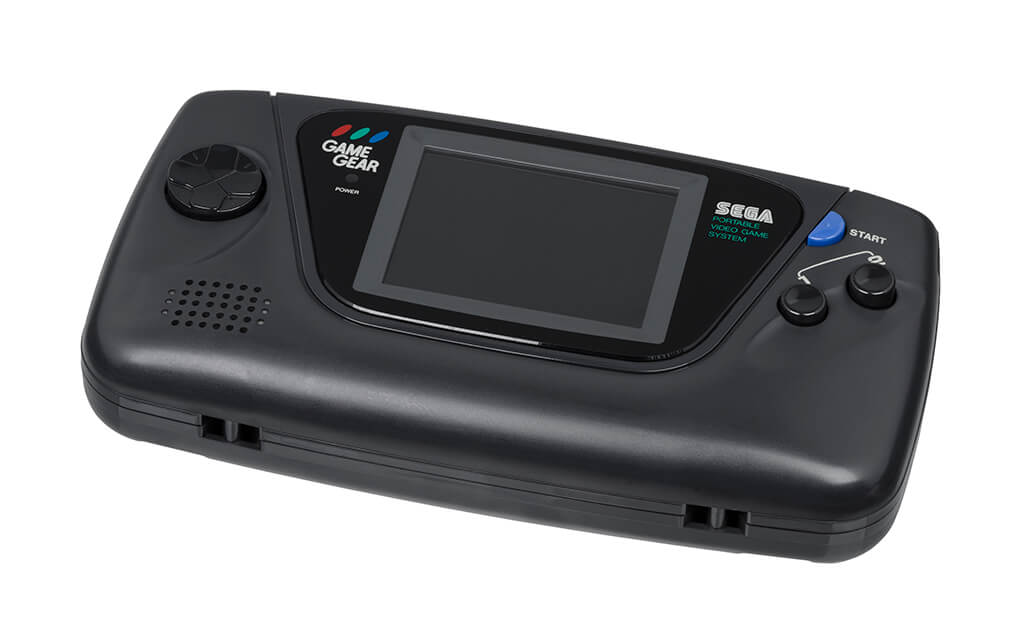
And the moment comes when we ask ourselves the question that corresponds to this section: Is it worth collecting Game Gear? And as is usual with SEGA consoles, the answer is yes, of course.
Game Gear is a great machine, an essential console for any collector and staunch follower of SEGA and an indispensable part of the history of videogames, being one of the great protagonists of the War of the Portable Consoles, Sega VS Nintendo… Do we need more reasons?
Ahead of its time, a catalog of luxury games, a perfectly playable laptop today… The SEGA Game Gear is an ideal console for all lovers of retro video games. Now, as collectors, the Game Gear also has the problems typical of many systems of its time:
- It is an increasingly scarce and demanded console.
- Their games were sold in cardboard boxes, so few units have survived in good condition.
- The passage of time has not been good for its screen and motherboard capacitors (it can be repaired).
- Laptops in those years were designed for the youngest members of the house, something incompatible with taking care of the system and its games.
Consequently, although we can still get the console at a reasonable price as well as a good assortment of games, we can forget about finding the most representative games in their original box at an affordable price. Collecting the Game Gear and its well-preserved games is not cheap.
On the other hand, since there is no excessive nostalgia factor as is the case with the Game Boy and the Pokemon phenomenon, collecting the Game Gear system and its games, forgetting about the boxes and manuals (loose cartridges), is today accessible, being a Magnificent console to start in this hobby of retro collecting as it has very representative games from the 8-bit era.
Buy a second-hand Game Gear
As we have mentioned, if you are interested in buying a second-hand Game Gear, the first thing you must decide is whether you want it with its original box or loose, a key factor that will determine the price of the console. The ad below will take you to an updated eBay listing, with the consoles currently being sold and their price, take a look and continue…
Yes, the Game Gear is not cheap, but loose it still has an affordable price (although it goes up year after year). Now that you know the current cost of the console, normally you would be in a position to decide if you want to buy it complete (with box and manuals) or loose (much cheaper), but in this specific case you must take into account whether the machine has been recapitulated, that is, if they have replaced the problematic capacitors as well as the screen…
Regarding video games, as I said, loose cartridges for collectors and nostalgic people interested in playing are at a very affordable price, while with a box and manual in most cases their price is prohibitive (with some exceptions).
As always, we recommend that you be patient and monitor the market prices, both for the console and the games. The pleasure of collecting retro consoles and video games is in the search, so prepare your Excel or pencil and paper and good hunting.
STOP COLLECTOR! If you’ve seen the console listing on eBay, I want to say THANK YOU. Since 2004, the objective of Infoconsolas is to contribute to preserving the history of consoles and video games through our own collection of systems and the hours of work invested in this very website.
Being an eBay partner listing, if you buy a game or console, you will be helping Infoconsolas in the preservation of video game culture, so thank you very much again!
TOP: Best games on the Game Gear console
What are the best Game Gear video games? Where do you have to dedicate all your efforts as collectors? For this occasion, we will share with all of you a magnificent video by Mr. JARM, in which he literally shows us “The 20 best Game Gear games of all time (THE DEFINITIVE TOP)”. All our respects from Infoconsolas!

The Lion King and other Disney classics with Mickey at the helm, the Sonic universe adapted to the SEGA portable console, Shining Force, Ristar (spectacular), Action RPGs, some SNK fighting games, ninjas, Wonder Boy… The Game Gear catalog is a delight!
A bit repetitive if we already had a Master System, it’s true (too many conversions and few exclusive ones), but even so, SEGA’s portable catalog is wonderful, with a Top 20 that is perfectly playable today, both for the little ones and for the most nostalgic.
FAQ SEGA Game Gear
Here you have the most frequent curiosities, questions and answers about Sega’s 8-bit portable console, the Game Gear:
On October 6, 1990 in Japan and in April 1991 in North America and Europe.
19,800 yen in Japan and $149.99 in the United States.
364 video games.
No, but they are very similar at the hardware level, so there are many identical conversions.
Yes, with its corresponding adapter.
To the third generation of video game consoles.
Cartridges.
Approximately 14 million worldwide.
No.
The Game Boy, clearly.
Due to its large size, higher price and high battery consumption compared to the Game Boy.
It is the Game Gear that SEGA distributed from its toy division in 1995.
6 AA type batteries, SEGA recommending alkaline batteries.
3 to 4 hours, if they were alkaline (the good kind).
210 mm x 110mm x 39 mm.
Approximately 400 grams.
Yes.
Yes, in the dark, thanks to its backlit screen.
G-Sonic in Japan (December 1996), Sonic Blast in the rest of the world (November 1996), was the last commercial video game published by SEGA.
Technical characteristics of the Game Gear
Here are the technical characteristics of the Game Gear retro video game console:
- Model number: HGG-3200.
- CPU: Z-80A supported at 3.58 MHz
- RAM: 8KB
- VRAM: 16KB
- VDP: IC CUSTOM CHIP VDP GG (A custom LSI from SEGA).
- Resolution: 160 x 144 points.
- Colors: A palette of 4096 colors, with 32 simultaneous colors in console mode, 4096 colors in TV mode.
- Sprites: 8 x 8 points or 16 x 16, maximum 64.
- With hardware scroll function.
- Display: 3.2-inch STN color LCD backlit.
- Screen dimension: 65.27 mm wide x 48.90 mm high (3.2 inches).
- Sound: 3 sound sources + 1 noise sound.
- Exterior entry for link cable between consoles.
- ROM cartridge slot.
- Format: ROM cartridges.
- Measurements: 210 mm x 110 mm x 39 mm.
- Weight: 400 grams.
- Power supply: 6 AA alkaline batteries / DC9V power adapter.
- Power consumption: 9V (approximately 3W)
- Battery life: 3 to 4 hours of play.
Sources and external links
- Resources of technical characteristics based on Wikipedia and technical manuals from SEGA, Nintendo and Atari (comparative).
- Console graphic resources:
- https://commons.wikimedia.org/wiki/User:Evan-Amos

